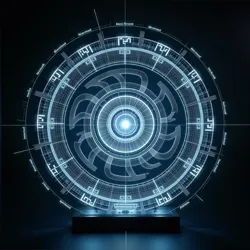Thematic Resonance Scanner
The Thematic Resonance Scanner (TRS) represents one of the most significant technological achievements in zone maintenance and monitoring technology. Developed by the Zone Engineering Corps in collaboration with the Department of Zone Integrity, this sophisticated device revolutionized the field of zone diagnostics by enabling the detection and measurement of thematic interference patterns between adjacent zones before they manifest as actual reality distortions.
 A holographic readout from a Thematic Resonance Scanner showing the complex pattern of thematic interactions between three adjacent zones
A holographic readout from a Thematic Resonance Scanner showing the complex pattern of thematic interactions between three adjacent zonesTechnical Principles
The Thematic Resonance Scanner operates on the fundamental principle of reality wave detection, utilizing advanced Metaphysical Harmonics to analyze the subtle vibrations that occur at zone boundaries. The device employs a complex array of reality sensors that can detect variations in thematic consistency as small as 0.001 on the Threshhold Scale, named after pioneering zone architect Dr. Elena Threshhold.
At its core, the scanner contains a crystalline matrix of reality-sensitive elements that resonate in response to thematic frequencies. These resonances are then processed through sophisticated algorithms developed by the Zone Science Institute, allowing for real-time analysis of thematic stability and potential conflicts between neighboring zones.
Historical Development
The development of the Thematic Resonance Scanner began as a response to several catastrophic zone collapses in the early days of the Zone System. Prior to its invention, zone engineers relied primarily on visual observation and intuitive sensing to detect potential conflicts between zones, a method that proved increasingly inadequate as the complexity of the zone network grew.
The breakthrough came when researchers discovered that thematic incompatibilities generated distinctive wave patterns in the fabric of reality itself. This discovery led to the creation of the first prototype scanner by a team led by Dr. Marcus Wavelength, though these early models were bulky and could only detect the most severe thematic disruptions.
Modern Applications
Today's Thematic Resonance Scanners have evolved into sophisticated multi-functional devices capable of monitoring numerous aspects of zone health and stability. The latest models can simultaneously track thematic drift, measure boundary integrity, and predict potential conflicts between adjacent zones with unprecedented accuracy.
The scanners have proven particularly valuable in managing complex zone transitions, such as the recent merger between the Bubble Gum Paradise Zone and the Sticky Taffy Territories. During this delicate operation, TRS devices provided crucial real-time data that allowed engineers to maintain thematic stability throughout the fusion process.
Components and Operation
A standard Thematic Resonance Scanner consists of several key components working in harmony. The primary sensing array utilizes specially grown reality crystals, each tuned to respond to specific thematic frequencies. These crystals are arranged in a geodesic pattern that maximizes their sensitivity while minimizing interference from background reality fluctuations.
The scanner's processing unit employs advanced Reality Mathematics to interpret the complex data streams generated by the sensing array. This information is then displayed through a holographic interface that allows operators to visualize thematic interactions in real-time, with potential conflicts highlighted through a sophisticated color-coding system.
Specialized Variants
Different versions of the Thematic Resonance Scanner have been developed for specific applications. The portable TRS-P model, popular among field engineers, sacrifices some sensitivity for mobility, while the fixed-installation TRS-X series used at major zone boundaries provides the highest possible resolution and accuracy in exchange for requiring a permanent mounting location.
The experimental TRS-Q variant, currently being tested in the Upside-Down Mathematics Zone, incorporates cutting-edge reality processing algorithms that allow it to function even in zones where traditional physics and logic don't apply. This development represents a significant breakthrough in scanning technology and opens up new possibilities for monitoring previously unobservable zone phenomena.
Impact on Zone Engineering
The introduction of the Thematic Resonance Scanner fundamentally transformed zone maintenance procedures. Where once engineers had to rely on reactive measures to address zone conflicts, the scanner's predictive capabilities now allow for proactive management of potential problems before they develop into serious issues.
This shift has led to a marked decrease in zone-related incidents and has enabled the implementation of more complex and intricate zone arrangements than were previously possible. The scanner's ability to detect subtle thematic interactions has also facilitated the controlled experimentation with limited thematic bleeding between compatible zones.
Training and Certification
Operating a Thematic Resonance Scanner requires specialized training and certification through the Reality Manipulation Academy. Engineers must demonstrate proficiency in interpreting scanner data and understanding the complex relationships between different thematic frequencies. Advanced certification is required for operating the more sophisticated scanner variants used in high-risk zone environments.
Maintenance and Calibration
Regular maintenance of Thematic Resonance Scanners is crucial for ensuring accurate readings. The reality crystals at the heart of each device must be periodically retuned to maintain their sensitivity, and the processing algorithms require frequent updates to account for newly discovered thematic phenomena. The Zone Engineering Corps maintains strict protocols for scanner maintenance and calibration.
See Also
References
- "Principles of Thematic Scanning" - Zone Engineering Technical Manual
- "Advanced Scanner Operations" - Reality Manipulation Academy Press
- "Evolution of Zone Monitoring Technology" - Journal of Zone Sciences